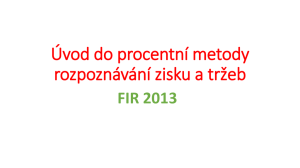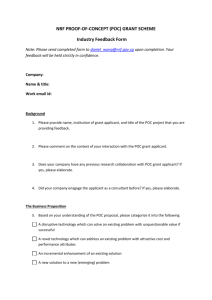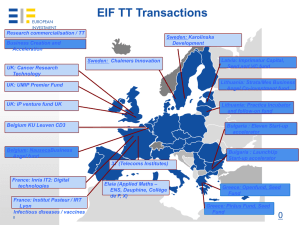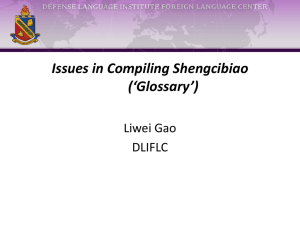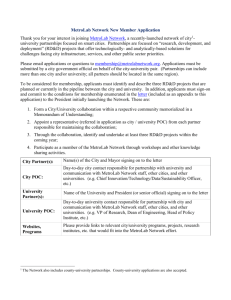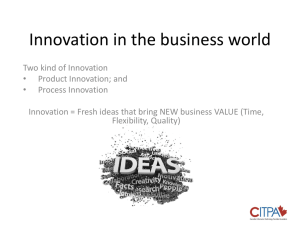Grading Assignment #6 Assignment #6 is worth 25 points. It is
advertisement
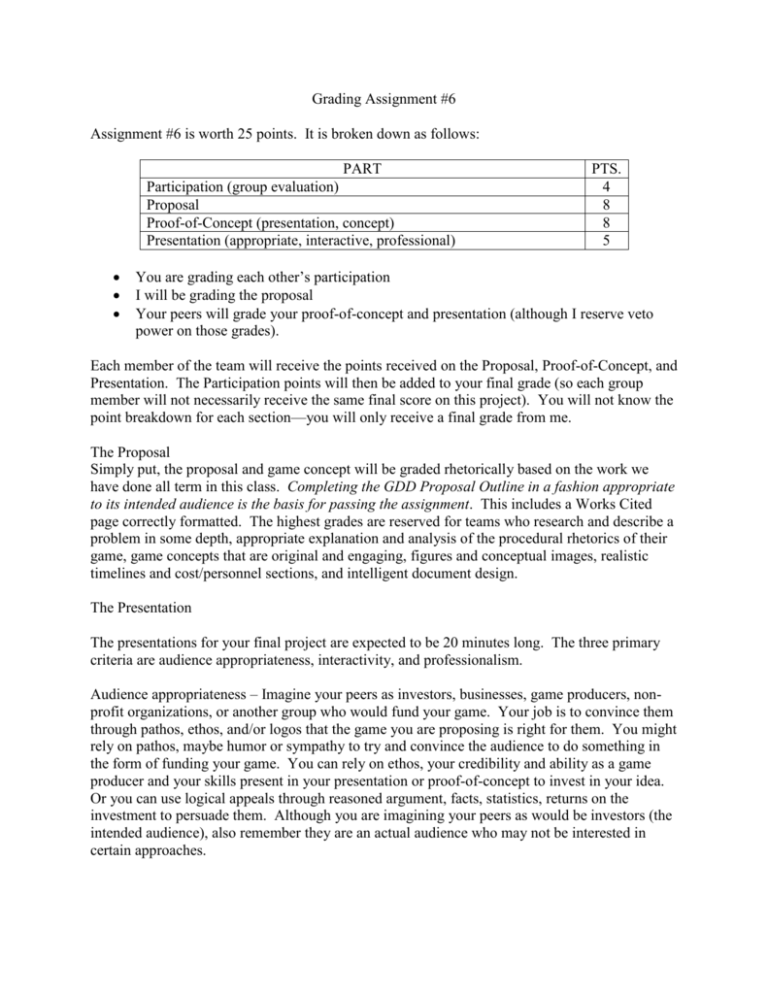
Grading Assignment #6 Assignment #6 is worth 25 points. It is broken down as follows: PART Participation (group evaluation) Proposal Proof-of-Concept (presentation, concept) Presentation (appropriate, interactive, professional) PTS. 4 8 8 5 You are grading each other’s participation I will be grading the proposal Your peers will grade your proof-of-concept and presentation (although I reserve veto power on those grades). Each member of the team will receive the points received on the Proposal, Proof-of-Concept, and Presentation. The Participation points will then be added to your final grade (so each group member will not necessarily receive the same final score on this project). You will not know the point breakdown for each section—you will only receive a final grade from me. The Proposal Simply put, the proposal and game concept will be graded rhetorically based on the work we have done all term in this class. Completing the GDD Proposal Outline in a fashion appropriate to its intended audience is the basis for passing the assignment. This includes a Works Cited page correctly formatted. The highest grades are reserved for teams who research and describe a problem in some depth, appropriate explanation and analysis of the procedural rhetorics of their game, game concepts that are original and engaging, figures and conceptual images, realistic timelines and cost/personnel sections, and intelligent document design. The Presentation The presentations for your final project are expected to be 20 minutes long. The three primary criteria are audience appropriateness, interactivity, and professionalism. Audience appropriateness – Imagine your peers as investors, businesses, game producers, nonprofit organizations, or another group who would fund your game. Your job is to convince them through pathos, ethos, and/or logos that the game you are proposing is right for them. You might rely on pathos, maybe humor or sympathy to try and convince the audience to do something in the form of funding your game. You can rely on ethos, your credibility and ability as a game producer and your skills present in your presentation or proof-of-concept to invest in your idea. Or you can use logical appeals through reasoned argument, facts, statistics, returns on the investment to persuade them. Although you are imagining your peers as would be investors (the intended audience), also remember they are an actual audience who may not be interested in certain approaches. Interactivity – nobody wants to be talked at for 20 minutes. For one, short-term and working memory can only retain 7 bits of information (the so-called Miller’s Magic Number), and if no processing is occurring, whether writing notes or even doodling (Andrade et al., 2009), people will forget (your audience will probably not take notes). Also recognize that your audience has different learning styles, some process more behaviorist approaches while others want bigger picture, abstract concepts. Interact with your entire audience by asking questions, providing handouts and information they can refer to, and letting them have hands-on access to your game or proof-of-concept. If you are worried, break people into groups, and have each presenter work with a small group. Think advertising strategies here—demonstrative, illustrative, and associative. You want to tell them about your game, show it to them, and associate happiness and their company’s well-being with your game concept. Professionalism –There are two levels to professionalism. First and foremost, be prepared for anything. If you have a proof-of-concept for everybody to play, make sure you can give them all access immediately and play test it on different computers. If you are showing storyboards in one medium, have a backup plan in case your computer crashes or aliens abduct the sole group member who has all the information (or he/she gets stuck in traffic). Remember that you cannot send files over 3MB over DU mail. The second part of professionalism doesn’t mean to be serious all the time—it means to be appropriate to your game and purpose. If your game is set in Hawaii, come in Hawaiian shirts; if it is an antiadvergame against Best Buy, come in blue shirts and khakis. If you want to be serious, dress up. If you want to have fun, break out the ironic tshirts. Give out candy for the person who can beat your game. Above all, as audience and presenter, recognize that a lot of work went into these projects, so do that work justice. You should cover the following: The problem Your pitch or game idea General gameplay Explain the proof-of-concept Other considerations: Hands-on / demo proof-of concept Storyboard walkthrough CBA (cost/benefit analysis) Video or audio demos PowerPoint of the presentation and/or game Costumed shenanigans Inventive use of the time to produce an engaging game pitch Grading the presentations You will grade the presentations on the following scale: 5 (excellent) 4 (superior) 3 (good) 2 (fair) 1 (poor) The total of the three will be divided by 3 to get the total points for presentation. Audience appropriateness 5 4 3 2 1 Interactivity 5 4 3 2 1 Professionalism 5 4 3 2 1 These grades will then be averaged for your total Presentation grade. The Proof-of-Concept (PoC) The PoC is a multimedia representation of the proposed game idea. This can be a static or interactive storyboard using video, paper, or multimedia authoring software. Or, it could be a hyperlinked representation of the game using HTML, PowerPoint, or Word. Or, it could be a produced and edited video or audio that uses original or existing footage to represent the gameflow or gameplay. The PoCs won’t be perfect games, but they should represent the game in a way appropriate to the game’s intended audience and also show some professional engagement on behalf of the team producing it. Overall, you will be graded at two levels: Concept and professionalism. Concept – Is the PoC fun, engaging, interesting, or is it a boring series of stick figure drawings on notebook paper? Sometimes a boring game presentation can be saved by a well-done, challenging, and engaging PoC. Just remember, usually the PoC isn’t the finished game—it’s a representation of the game that can help the audience better understand how a game might work. Also, remember that by concept you are grading the PoC and the proposed game it represents. Professionalism – Did your team put effort into the PoC or not? That’s really what you are representing with professionalism. If the PoC is a six panel storyboard with stick figures and 4 lines of dialogue, that is a poor representation of the game. If, however, there is a fully functioning game demo, that would be rated higher. A note about audience The Presentation is for your peers as investors—the PoC serves the purpose of being both for the investors and for the game’s intended audience. If your PoC is a flippant and superficial walkthrough of your game, Genocide in Darfur, this is not appropriate for either audience. The PoC is asking your audience to imagine the game you are proposing, and in so doing, you are asking them to imagine playing as the intended audience of the game. Grading the presentations Grading the PoCs will present an opportunity to consider criteria appropriate to the PoC genre. How do you judge a product that is a 15 item storyboard versus a project that is a completed game? That’s up to the rhetorical situation. If the storyboard is funny, interesting or educational, then it’s selling the game more than a rudimentary or poorly functioning Flash game. Remember, you are talking to investors here, so your PoC is successful if it makes the audience interested in funding your project. That said, your PoC is also showing what the game’s intended audience will experience. You will grade the presentations on the following scale: 5 (excellent) 4 (superior) 3 (good) 2 (fair) 1 (poor) The total will be divided by 1.25 to get the total points for the PoC. Concept 5 4 3 2 1 Professionalism 5 4 3 2 1 These grades will then be averaged for your total PoC grade. Participation Each group member will email me with an assessment of their group members. You will write 2-3 sentences about each group member about what everyone contributed to the project. You will then grade each member on a 5 point scale: 5 (excellent) 4 (superior) 3 (good) 2 (fair) 1 (poor) I will average these grades across the group and also add/subtract based on any special circumstances that I witnessed during work on the project and assign a final grade. Example Bob Roberts wrote the first draft of the proposal and participated in group work days. He didn’t do any of the work on the PoC, but he definitely put his hours in on the Proposal and in preparing a PPT for the presentation. GRADE: 4

